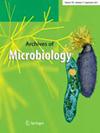Production of biologically active recombinant salmon calcitonin in Escherichia coli and fish cell line
Abstract
Salmon calcitonin is a small peptide hormone synthesised and released by a specialised gland called ultimobranchial gland in fish. This hormone has been used to treat osteoporosis for over 50 years. The aim of this study was to compare the efficacy of five repeats of salmon calcitonin (5sCT) produced in two different hosts (bacteria and fish cell line). The 5sCT gene was synthesised and cloned in prokaryotic (pET32b(+)) and eukaryotic (pcDNA 3.1 + and pGenlenti) vectors. The pET32 b cloned plasmid was transformed into bacterial host BL 21 (DE3) and expression of recombinant 5sCT was induced by IPTG. The 5sCT cloned pcDNA 3.1 and pGenlenti plasmids were transfected using Lipofectamine 3000 in snubnose pompano fin (SPF) cell line. The expression of recombinant 5sCT protein in both hosts was confirmed by Western blot and ELISA using a polyclonal antibody raised against r-5sCT in mice. The results of Western blot and ELISA confirmed the expression of 5sCT protein in E. coli and SPF cells. The purified r-5cST expressed from both hosts was evaluated in mice via intramuscular injection at various dosages, and it was found that it significantly decreased serum calcium levels in mice when compared to normal mice.


 求助内容:
求助内容: 应助结果提醒方式:
应助结果提醒方式:


